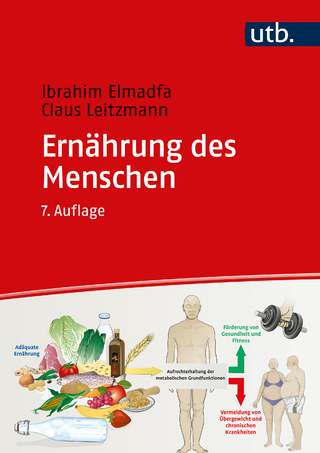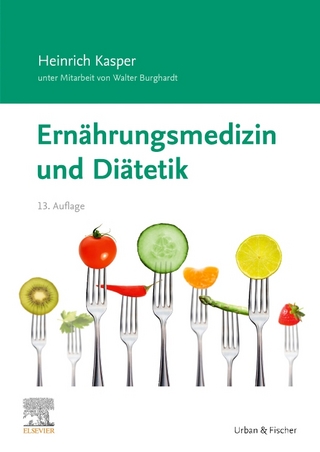
Food, diet and obesity
Crc Press Inc (Verlag)
978-0-8493-3440-5 (ISBN)
- Titel ist leider vergriffen;
keine Neuauflage - Artikel merken
Arguably the most serious issue facing the food industry is what is now widely recognized as an epidemic in obesity. Food manufacturers are under increasing pressure over both the degree to which they have contributed to the problem and what role they should play in solving it. Drawing on the expertise of some of the world’s leading experts in this area, Food, Diet and Obesity summarizes current research on the causes of obesity, the role of food components in promoting or reducing weight gain, and the strategies manufacturers can adopt to reduce the problem. After an introductory chapter on global trends in obesity, Part 1 looks at the range of contributing factors to obesity, from nutrient-gene interactions, energy metabolism and physical activity to sensory responses to food, portion size and the psychology of overeating. Part 2 looks at macronutrients and their role in weight gain or loss, with chapters on topics such as energy density, dietary fat, carbohydrates, protein and dietary fibre. The final part of the book discusses issues in developing effective strategies for weight control, from gaining consumer acceptance of weight-control food products to the role of community-based approaches in preventing obesity.
With its distinguished editor and international team of experts, Food, Diet and Obesity will be a standard work for nutritionists and R&D staff throughout the food industry, as well as all those concerned with understanding and reducing obesity.
PART 1 CONTRIBUTING FACTORS
Nutrient–gene interactions contributing to the development of obesity
C Verdich, Danish Epidemiology Science Centre; K Clement, INSERM, France; and T Sorenson, Copenhagen University Hospital, Denmark
Introduction. Genetic influences on obesity. Nutrient-sensitive genes. Interactions between genetic background and diets. Managing obesity: dietary and other strategies. Future trends. Sources of further information and advice. References.
Energy metabolism and obesity
A Astrup, Royal Agricultural and Veterinary University, Denmark
Introduction. How to measure energy expenditure. Major components of daily expenditure. Interaction between energy intake and physical activity. Energy expenditure at different ages. Energy expenditure and balance in obesity. Producing a negative energy balance in obese subjects. Summary. Glossary. Further reading.
Physical activity and obesity
K Westerterp, Maastricht University, The Netherlands
Introduction. Activity-induced energy expenditure and obesity. Activity types, level and obesity. The role of activity in weight loss programs. Physical activity, physical fitness and weight maintenance. Implications and recommendations for physical activity and weight management. Future trends. Sources of further information and advice. References.
Infant nutrition and adult obesity
M Goran, M Cruz, G Shaibi, M Weigensberg, D Spruijt-Metz, C Ebbeling, and D Ludwig, University of Southern California, USA
Introduction. Trends in children’s diets as a factor in obesity. Obesity and chronic disease risk in children and adolescents. Increased body fat and health risk in children. Nutrition-based prevention and treatment of obesity and related disease risk. Summary and implications: multiple targets for treatment and prevention. References.
The psychology of overeating
C Herman, J Polivy and T Leone, University of Toronto, Canada
Introduction. Historical overview. Modern theories of overeating and its causes. Types of overeating. Implications for reducing obesity. References.
Sensory responses, food acceptance and obesity
C de Graaf, Wageningen University, The Netherlands
Introduction. Sensory perception, preference and food intake. Changing sensory responses to food intake. Sensory perception and preference of food by obese consumers. Making weight control foods more attractive to consumers. Implications, recommendations and future trends. References.
Portion size and food intake
B Rolls, J Ello-Martin and J Ledikwe, The Pennsylvania State University, USA
Introduction: the growth in portion sizes. Studies showing that portion size effects energy intake. Eating out and portion size. Portion size, energy intake and obesity. Strategies to moderate the influence of portions size on energy intake. The future: the eating environment and obesity. References.
PART 2 MACRONUTRIENT INFLUENCES ON WEIGHT LOSS
Energy density and weight control
S Whybrow, The Rowett Research Institute, UK; N Mazlan, International Islamic University of Malaysia; and R J Stubbs, The Rowett Research Institute, UK
Introduction. Definitions. Influence of diet composition on energy density. Relationships between food composition, energy density and energy intake. Relationship between obesity, food choice and energy density. Energy density and learned aspects of satiety. Energy density in the context of other influences on intake. Implications for the global food industry and public health strategies. Conclusions. References.
Dietary fat and weight control
M Noakes, CSIRO Health Sciences and Nutrition, Australia
Introduction. Dietary fat and obesity: epidemiological studies. Dietary fat and obesity: cohort studies. Mechanisms linking dietary fat and weight gain. Low-fat diets and weight loss. Summary and conclusions. References.
Carbohydrates, glycemic responses and weight control
K Teff, Monell Chemical Senses Center, USA
Introduction. The glycemic index (GI): definition and methodological issues. Factors affecting the glycemic index of foods. Glucose response and chronic disease. GI foods, food intake and weight control. References.
Protein intake and weight control
P Clifton, CSIRO Health Sciences and Nutrition, Australia
Introduction. Protein intake and satiety. Protein intake and energy intake. Short and long term term studies of protein intake and its effects. Very low carbohydrate, high protein diets. Safety of high protein diets. Future trends. Sources of further information and advice. References.
Alcohol, energy balance and obesity
R D Mattes, Purdue University, USA
Introduction. Drinking patterns. Links between moderate alcohol ingestion and body weight. Alcohol and energy intake. Alcohol and body composition. Summary and research needs. References.
The use of fat replacers for weight loss and control
J Miller, College of St Catherine, USA; and S Jonnalagadda, Novartis Medical Nutrition, USA
Introduction. Types of fat replacers. The role of fat replacers in weight loss. Conclusions. References.
Intense sweeteners and sugar replacers in the regulation of food intake and body weight
R Abou Samra and G Harvey Anderson, University of Toronto, Canada
Introduction. Intense sweeteners, sugar replacers and weight control. Caloric sugar replacers: sugar alcohols. Non-caloric sugar replacers: high-intensity sweeteners. Implications and recommendations. References.
Dietary fibre and weight control
K Ryttig, Farmaservice Ltd., Denmark
Introduction. Defining dietary fibre. Defining obesity. Dietary fibre and the treatment of obesity. Dietary fibre and chronic diseases associated with obesity. Conclusion and future trends.
PART 3 COMMERCIAL STRATEGIES, FUNCTIONAL TARGETS AND AGENTS IN WEIGHT CONTROL
Consumer determinants and intervention strategies for obesity prevention
H C M van Trijp, Wageningen University, J Brug, Erasmus University Medical Centre, and R van der Maas, Unilever Health Institute, The Netherlands
Introduction. Behavioural determinants of obesity. Intervention strategies. Conclusions. References.
Fat oxidation, appetite and weight control
M Leonhardt and W Langhans Swiss Federal Institute of Technology
Introduction. Inhibition of fatty acid oxidation and food intake. Increased peripheral fatty acid oxidation and food intake. Increased fatty acid oxidation in the brain. Effects of changes in fatty acid oxidation on glucose tolerance. Implications and recommendations. Conclusions and future trends. References.
The use of very low calorie diets (VLCDs) and meal replacers for weight control
J W Anderson and E C Konz, University of Kentucky, USA
Introduction. Tailoring nutritional advice for weight control. Physical activity approaches. Behaviour modification. Comparative weight loss with different nutrition approaches. Very-low-calorie diets. Low-calorie diet use. Meal replacement use. Implications and recommendations. Conclusions and future trends. Sources of further information and advice. References.
The effectiveness of popular diets: an overview
H Raynor and R Wing, Brown Medical School, USA
Introduction. Weight control practices amongst consumers. Criteria for evaluating weight loss programs. Evaluating the main types of weight management program. Physical activity and weight loss programs. Delivery methods used in weight loss programs. Implications and recommendations. References.
Calcium and obesity
S I Barr University of British Columbia, Canada
Introduction. Possible mechanisms linking calcium/dairy intake and body weight regulation. Epidemiological studies. Randomized trials in humans. Human metabolic studies. Gaps in the literature and directions for future research. Implications and recommendations. Sources of further information and advice. References.
Community-based approaches to prevent obesity
C Bell, Deakin University, Australia
Introduction. What has worked in other public health epidemics? Elements in a community-based approach to obesity prevention. Evaluating community-based projects for obesity prevention. Conclusion. Acknowledgements. References.
Behavioural and metabolic targets for the prevention and control of obesity
M Westerterp-Plantenga, Maastricht University, The Netherlands
Introduction. Controlling energy intake through eating behaviour. Satiety. The effects of conjugated linoleic acid and other ingredients on energy efficiency and body composition. Energy intake, expenditure and storage: a synthesis. Future trends. References and further reading.
A commercial R&D perspective on weight control foods
D J Mela, Unilever, Netherlands
Introduction. Commercial approaches to weight control. Formulating weight control products. Efficacy testing of weight control products. Summary and conclusions. Future trends. Implications and recommendations. References.
| Erscheint lt. Verlag | 1.11.2005 |
|---|---|
| Verlagsort | Bosa Roca |
| Sprache | englisch |
| Maße | 152 x 229 mm |
| Gewicht | 953 g |
| Themenwelt | Medizin / Pharmazie ► Gesundheitsfachberufe ► Diätassistenz / Ernährungsberatung |
| Medizin / Pharmazie ► Medizinische Fachgebiete | |
| ISBN-10 | 0-8493-3440-3 / 0849334403 |
| ISBN-13 | 978-0-8493-3440-5 / 9780849334405 |
| Zustand | Neuware |
| Haben Sie eine Frage zum Produkt? |
aus dem Bereich


